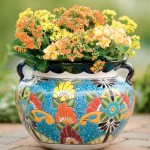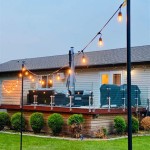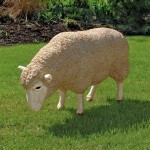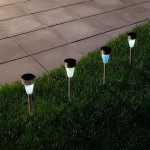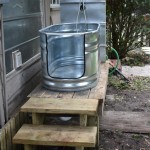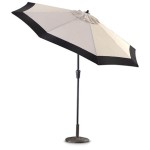Choosing the Best Fan for Your Outdoor Patio
Selecting the right fan for an outdoor patio requires careful consideration of several factors, including the patio's size, climate, desired airflow, and aesthetic preferences. The goal is to create a comfortable and enjoyable outdoor space, even during hot and humid weather. Several fan types are available, each with unique advantages and disadvantages. Understanding these differences is crucial for making an informed decision.
Outdoor spaces present distinct challenges compared to indoor environments. Fans must be durable enough to withstand exposure to the elements, including rain, sun, wind, and temperature fluctuations. Additionally, safety is paramount, particularly regarding electrical components and the fan's mounting mechanism. The following sections explore various fan types suitable for outdoor patios, highlighting their key features and considerations.
Outdoor Ceiling Fans
Outdoor ceiling fans are a popular choice for patios, decks, and porches. These fans are designed to be weather-resistant and are typically rated for damp or wet locations. A damp-rated fan can withstand moisture and humidity, while a wet-rated fan is designed to withstand direct exposure to rain and other elements.
The size of the patio is a crucial factor in determining the appropriate ceiling fan size. A smaller patio may only require a fan with a blade span of 44 inches, while larger patios may benefit from fans with blade spans of 52 inches or more. The height of the ceiling should also be considered. If the ceiling is low, a flush-mount fan may be necessary to provide adequate clearance. Standard downrods are generally used for ceilings of average height, while longer downrods are needed for higher ceilings to ensure optimal airflow.
The materials used in outdoor ceiling fans are designed to withstand the elements. Blades made from all-weather plastic, sealed wood, or rust-resistant metal are ideal choices. Similarly, the motor housing should be made from a durable and weather-resistant material, such as powder-coated aluminum or stainless steel. Some models feature specially treated finishes to further enhance their resistance to corrosion and fading.
Control options vary for outdoor ceiling fans. Some models come with a pull chain, while others are controlled by a remote or wall-mounted control panel. Remote controls offer convenience, allowing users to adjust the fan speed and lighting (if applicable) from anywhere on the patio. Wall-mounted controls provide a more permanent and accessible option, particularly for those who prefer a traditional switch.
Installation of outdoor ceiling fans should be performed by a qualified electrician to ensure proper wiring and mounting. It is important to use weatherproof electrical boxes and wiring to prevent water damage and electrical hazards. The fan should also be securely mounted to a structural support beam to ensure stability and prevent it from falling. Proper grounding is also essential for safety.
Outdoor Wall-Mounted Fans
Outdoor wall-mounted fans offer a space-saving alternative to ceiling fans, particularly in areas where ceiling height is limited or where a ceiling fan is not feasible. These fans are typically smaller and more compact than ceiling fans, making them suitable for smaller patios, balconies, and covered porches.
Like ceiling fans, outdoor wall-mounted fans are designed to be weather-resistant. They are typically rated for damp or wet locations and are made from durable materials that can withstand exposure to the elements. The fan blades and motor housing should be constructed from corrosion-resistant materials, such as plastic, stainless steel, or powder-coated metal.
One of the key advantages of wall-mounted fans is their directional airflow. These fans can be positioned to direct airflow to specific areas of the patio, providing targeted cooling. Many models feature adjustable tilt and swivel mechanisms, allowing users to customize the airflow direction to their liking. This can be particularly useful for creating a cool breeze in a specific seating area or for ventilating a barbecue area.
Wall-mounted fans are typically easier to install than ceiling fans. They can be mounted directly to a wall using screws and anchors. However, it is important to ensure that the wall is structurally sound and capable of supporting the fan's weight. If the wall is made of brick or concrete, specialized anchors may be required. Electrical wiring should be installed by a qualified electrician to ensure safety and compliance with local building codes.
Control options for wall-mounted fans vary. Some models come with a pull chain, while others are controlled by a remote or a wall-mounted switch. Remote controls offer convenience, while wall-mounted switches provide a more traditional control option. Some models also feature multiple speed settings, allowing users to adjust the airflow to their desired level.
Outdoor wall-mounted fans are a versatile and practical solution for cooling outdoor spaces. Their compact size, directional airflow, and ease of installation make them an excellent choice for patios, balconies, and covered porches. When selecting a wall-mounted fan, it is important to consider the fan's weather resistance, size, airflow capacity, and control options.
Outdoor Pedestal Fans
Outdoor pedestal fans, also known as standing fans, are portable and adjustable cooling solutions for patios and other outdoor areas. Unlike ceiling and wall-mounted fans, pedestal fans can be easily moved and positioned to provide targeted airflow wherever it is needed most. This flexibility makes them ideal for entertaining guests, working outdoors, or simply relaxing on the patio.
Outdoor pedestal fans are designed to be more robust than their indoor counterparts. They are typically constructed from durable materials that can withstand exposure to the elements, such as rust-resistant metal or high-impact plastic. The base of the fan is usually weighted to provide stability and prevent it from tipping over in windy conditions. Some models also feature adjustable height and tilt settings, allowing users to customize the airflow direction and coverage area.
One of the key advantages of pedestal fans is their portability. They can be easily moved from one location to another, making them ideal for use on patios, decks, gardens, and other outdoor spaces. This portability also makes them a convenient option for storage during the off-season. When not in use, the fan can be easily disassembled and stored in a garage, shed, or closet.
Pedestal fans typically feature multiple speed settings, allowing users to adjust the airflow to their desired level. Some models also have an oscillation function, which allows the fan to rotate back and forth, providing wider coverage. This can be particularly useful for cooling larger areas or for circulating air in a stagnant space.
Powering pedestal fans is typically done through a standard electrical outlet. It is important to use a weatherproof extension cord if the outlet is located far from the fan. Some models may also feature a battery-powered option, allowing for cordless operation. This can be particularly useful in areas where access to an electrical outlet is limited.
Outdoor pedestal fans offer a convenient and flexible cooling solution for patios and other outdoor spaces. Their portability, adjustable settings, and multiple speed options make them an excellent choice for creating a comfortable and enjoyable outdoor environment. When selecting a pedestal fan, it is important to consider the fan's durability, portability, airflow capacity, and power source.
Misting Fans
Misting fans provide a dual cooling effect by combining airflow with a fine mist of water. The evaporation of the water absorbs heat from the surrounding air, creating a refreshing and comfortable environment. These fans are particularly effective in hot and dry climates, where the evaporative cooling process is most pronounced.
Outdoor misting fans are available in various types, including portable pedestal models, wall-mounted units, and even ceiling fan models with integrated misting systems. Portable misting fans are ideal for patios, decks, and poolside areas, while wall-mounted units are suitable for covered porches and outdoor kitchens. Ceiling fan models with misting systems offer a more permanent and integrated cooling solution.
The key component of a misting fan is its misting system, which typically consists of a water reservoir, a pump, and a series of nozzles. The pump draws water from the reservoir and forces it through the nozzles, creating a fine mist that is dispersed into the air by the fan blades. The water reservoir can be filled manually or connected to a water supply line for automatic refilling.
The effectiveness of a misting fan depends on several factors, including the humidity level, the air temperature, and the fan's airflow capacity. In humid climates, the evaporative cooling effect is less pronounced, as the air is already saturated with moisture. However, even in humid conditions, misting fans can still provide a noticeable cooling effect by creating a localized microclimate.
Misting fans require regular maintenance to ensure optimal performance. The water reservoir should be cleaned periodically to prevent the growth of algae and bacteria. The nozzles should also be cleaned regularly to prevent clogging. Some models feature self-cleaning nozzles, which automatically clear any debris that may accumulate.
Misting fans offer a unique and effective cooling solution for outdoor spaces. Their combination of airflow and evaporative cooling can create a refreshing and comfortable environment, even in hot and dry climates. When selecting a misting fan, it is important to consider the fan's type, misting system, airflow capacity, and maintenance requirements.
Considerations Beyond Fan Type
Beyond the type of fan, several other factors contribute to its overall performance and suitability for an outdoor patio. These include the fan's energy efficiency, noise level, lighting options, and style.
Energy efficiency is an important consideration, particularly for fans that will be used frequently. Look for fans with Energy Star ratings, which indicate that they meet certain energy efficiency standards. These fans typically consume less electricity than standard models, reducing energy costs and minimizing environmental impact. DC motor fans tend to be more energy efficient than AC motor fans. DC motors are also often quieter.
The noise level of the fan is also a factor to consider, particularly for patios that are used for relaxation or entertaining. Some fans are quieter than others, depending on their motor design and blade construction. Look for fans with noise ratings below 50 decibels to ensure a quiet and comfortable environment. Blade material and balance also come into play.
Lighting options can enhance the functionality and ambiance of an outdoor patio. Many outdoor ceiling fans come with integrated light kits, providing both cooling and illumination. These light kits can be equipped with LED bulbs, which are energy-efficient and long-lasting. The style of the fan should also complement the overall design of the patio. Choose a fan that matches the patio's furniture, décor, and architectural style.
By considering these factors in addition to the type of fan, one can select the best option for creating a comfortable and enjoyable outdoor patio space.

9 Best Outdoor Ceiling Fans For The Patio Family Handyman

Best Outdoor Ceiling Fans For Patios Decks Com

Best Outdoor Ceiling Fans Lightology

How To Choose The Best Ceiling Fan Home Ca

Minka Aire Xtreme H2o Indoor Outdoor Ceiling Fan 2modern

Stay Cool This Summer With The Top Affordable Outdoor Fan Youtube

Best Outdoor Ceiling Fans Lightology

Outdoor Ceiling Fans How To Choose The Best Fan For Your Space

Cool Your Patio Off With The Best Outdoor Ceiling Fans

True 52 Ceiling Fan White


